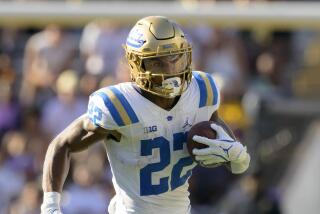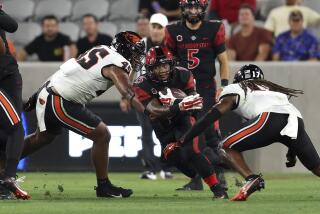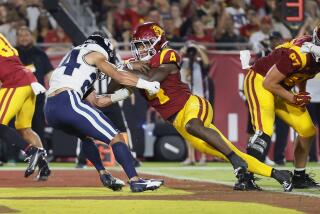PACIFIC 10 CONFERENCE : There’s More Than Just a Big 3 This Year
Oregon football Coach Rich Brooks contends that there isn’t a bad team in the Pacific 10 Conference and the previous have-nots in the league have narrowed the talent gap with USC, UCLA and Washington.
If so, this could be the year an upstart team wins the conference title.
Parity hasn’t been evident, though, in the league since 1972. USC or UCLA have represented the Pac-10 in the Rose Bowl 14 times in that span, with Washington making three appearances and Arizona State one.
USC has been the dominant team recently with three consecutive championships and only one conference loss in that span, to Oregon in 1987.
The Trojans are widely favored again but that is primarily based on USC’s track record, not necessarily on the relative strength, or experience of its team this season.
It’s not likely that Oregon State or California will suddenly be a contender, but a case can be made for several teams preventing USC from winning a fourth consecutive conference title.
“I don’t think anybody can get through the league without a loss, as USC has in the last two years,” said Brooks, who is in his 14th season as Oregon’s coach.
“However, USC has to be the favorite for what they’ve done in the last three years. They have some questions, though, and everybody else has a chance, and some have better chances than others.
“The three teams that finished second last year have to be in the hunt--Oregon, Arizona and Washington. Most of the preseason people move Arizona and Washington up and drop us to the bottom half and that remains to be seen.
“If somebody forges upward, somebody has to go downward. UCLA obviously is a team that is going to rebound and be a major factor, and I hear great things about Arizona State. Stanford and Cal have legitimate cases for improved records. And Washington State and Oregon State return skilled people and talented quarterbacks.
“It’s a tough league. You can’t say someone is terrible, like it was. If you’re not ready every week, you can get beat, and it didn’t used to be that way.”
Schedules may be the determining factor as to which team represents the conference in the Rose Bowl.
In that regard, Washington apparently has an advantage, playing USC, UCLA, Arizona and Oregon at Husky Stadium.
With the exception of Brigham Young, Oregon has a relatively soft nonconference schedule and doesn’t play USC.
“That doesn’t break my heart,” Brooks said, referring to the omission of the Trojans on the schedule.
Once again, the Pac-10 will be recognized for its proficient quarterbacks.
Almost every team has an experienced quarterback, among them Arizona State’s Paul Justin, USC’s Todd Marinovich and Oregon’s Bill Musgrave.
“This league is incredible when you look at the quarterbacks,” Brooks said. “For instance, the NFL’s No. 1 draft choice, Troy Aikman, was only honorable mention in the conference two years ago.”
A closer look at the teams, excepting USC and UCLA, with 1989 overall and conference records:
ARIZONA
1989: 8-4, 5-3, second place
The Wildcats are the only Pac-10 member that hasn’t played in the Rose Bowl game, but they’re closing in on it.
“We have a better chance to be a better football team because, hopefully, we’ll throw the ball better,” Coach Dick Tomey said.
If so, quarterbacks Ronald Veal, a better runner than passer, and George Malauulu will have to deliver on a team that led the league in rushing last year with its option, I-bone attack, but was last in passing, averaging only 81.6 yards a game.
Malauulu showed some promise as a passer until he missed the last two games in 1989 with a knee injury.
Otherwise, the Wildcats appear solid with 12 returning starters and a strong running back corps that will be bolstered by the return of Art Greathouse, who was inactive with a foot injury last year.
Inspiration will be provided by Arizona linebacker Kevin Singleton, who has been medically cleared to play after having been found to have leukemia 13 months ago.
ARIZONA STATE
1989: 6-4-1, 3-3-1, fifth place
In a quarterback-talented conference, Paul Justin stands tall, figuratively and literally, at 6 feet 5.
He threw for nearly 1,500 yards in the last four games last season, including 534 against Washington State.
Justin will be throwing to young receivers and Coach Larry Marmie could take the pressure off his quarterback with a solid running game.
Leonard Russell, a 6-foot-3, 235-pound back, could be the catalyst. He has returned to ASU after two years at a community college, Mt. San Antonio.
The defense was the worst in the conference last year, allowing an average of 406.7 yards a game. But eight starters are back, among them talented free safety Nathan LaDuke.
“I don’t think there’s a more productive player in America than Nathan,” Marmie said.
CALIFORNIA
1989: 4-7, 2-6, 10th
California, which was a finesse team with graduated quarterback Troy Taylor, is trying to change to a more balanced attack.
Taylor is the school’s leader in passing yardage but also might have set another record as the most sacked quarterback in the school’s history.
The previously one-dimensional Bears will rely more on running backs Greg Wallace and Greg Zomalt, who will be operating behind a huge, experienced offensive line.
Coach Bruce Snyder hopes to take the pressure off inexperienced quarterbacks Mike Pawlawski and Perry Klein with an improved running game and six returning starters from a defense that yielded an average of 26.2 points a game in 1989.
Cal hasn’t had a winning season since 1982 and it remains to be seen whether a new offensive philosophy will dramatically alter its second-division status.
OREGON
1989: 8-4, 5-3, second place
Oregon made its first bowl appearance--Independence--in 26 years last season and Brooks has improved his program to the point that he will be disappointed if the Ducks don’t go to a bowl game again.
“We’ve got a good team and I think we can make a run at it,” Brooks said.
Oregon has lost its two leading ground gainers, Derek Loville and Latin Berry, but Brooks is enthusiastic about tailback Ngalu Kelemeni and Brandon Jumper, a 250-pound fullback.
Then there’s Musgrave, who passed for 2,761 yards and 20 touchdowns last year.
“I think he’s the best quarterback in the conference and one of the best in the nation,” Brooks said.
As for defense, Brooks said, “We lost some good players, but I feel good that we have a good group stepping up. We were second in total offense and defense in the conference last year and I don’t think we should fall far in those phases.”
The Ducks also have seven home games for the first time in the school’s history.
OREGON STATE
1989: 4-7-1, 3-4-1, sixth place
Four wins in a season the last two years may not seem like much to most schools, but for Oregon State, it’s a steppingstone.
With the exception of Nebraska, Oregon State has a light nonconference schedule and, with some luck, it might even win five games this season.
The Beavers have an overachieving quarterback, Matt Booher, who lifts weights with the linemen and passes effectively on the run.
He’ll have to move quickly this year with a rebuilt offensive line.
Coach Dave Kragthorpe has another battering fullback in 244-pound James Jones, replacing Pat Chaffey, a fifth-round draft choice of the Chicago Bears, and an exceptional nose guard in Esera Tuaolo.
Oregon State upset UCLA last year and may surprise some unsuspecting team this season.
STANFORD
1989: 3-5, 3-8, seventh place
Stanford, once the quarterback school of the country with the likes of Jim Plunkett and John Elway, is changing its image.
The quarterback position has been mediocre, at best, in recent years and it remains to be seen whether Jason Palumbis, who plunged to No. 4 on the depth chart last season but won the starting job in spring practice, is any more effective a passer than Steve Smith, who ranked eighth in the conference last year.
The Cardinal should have an effective running game with Jon Volpe, a 1,000-yard rusher who missed most of last season with injuries, along with Glyn Milburn and Ellery Roberts, transfers from Oklahoma and Miami, respectively.
Green also has some gifted receivers, notably Ed McCaffrey. And four of last year’s five starters on the offensive line return.
Defensively, Stanford has six starters from a unit that that was just average last season.
More will be known about Stanford after its opening two games, Colorado and UCLA, both on the road.
WASHINGTON
1989: 8-4, 5-3, second place
Rose Bowl fever is prevalent in Seattle, and even the new quarterback, left-handed Mark Brunell, is caught up with it.
“This is definitely a Rose Bowl team,” he said. “That’s our No. 1 goal. That’s all we talk about. We want the Rose Bowl, or we don’t want anything.”
The Huskies have lost some skilled players, such as All-American center Bern Brostek, quarterback Cary Conklin and 300-pound defensive lineman Dennis Brown.
Nonetheless, there is reason for optimism in the Husky camp.
Operating behind a mammoth offensive line, a trademark of Don James’ teams, will be talented tailback Greg Lewis, who rushed for 1,100 yards in James’ one-back set last year. There are skilled wide receivers Orlando McKay and Mario Bailey, and a robust defense led by linebacker James Clifford.
Now in his 16th season at Washington, James is the dean of Pac-10 coaches with a record of 119-51-2. He has also coached the Huskies into 11 bowl games, the most recent a 34-7 victory over Florida in the 1989 Freedom Bowl.
Washington hasn’t played in the Rose Bowl, though, since the 1981 season--and it apparently believes it is long overdue to return.
WASHINGTON STATE
1989: 6-5, 3-5, seventh place
Coach Mike Price is known for his motivational gimmicks, such as “shooting” a student, who was dressed as a USC Trojan and riding a horse around the practice field, with a track starter’s pistol.
He has also walked to practice in a duck-hunting outfit the week of the Oregon game and dressed like an Arizona State mascot while giving his team a pep talk.
Price will need more than gimmicks to inspire his Cougars this year, though, since he has only four defensive starters returning.
Price does have All-American kicker Jason Hanson and proven quarterbacks in Brad Gossen and Aaron Garcia.
More to Read
Go beyond the scoreboard
Get the latest on L.A.'s teams in the daily Sports Report newsletter.
You may occasionally receive promotional content from the Los Angeles Times.










